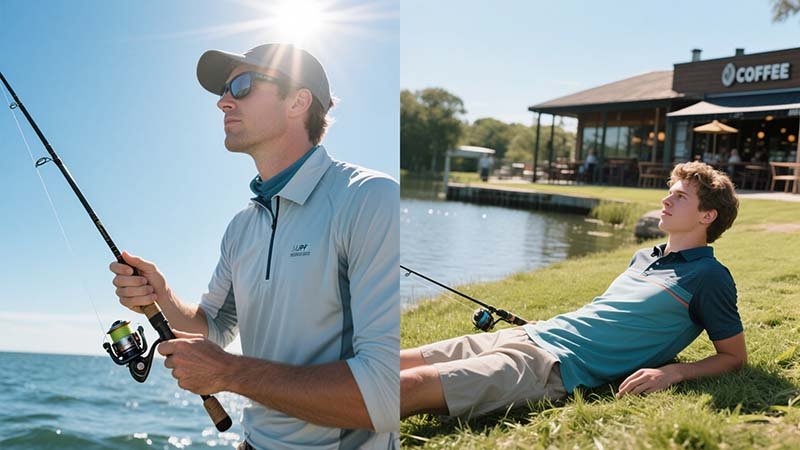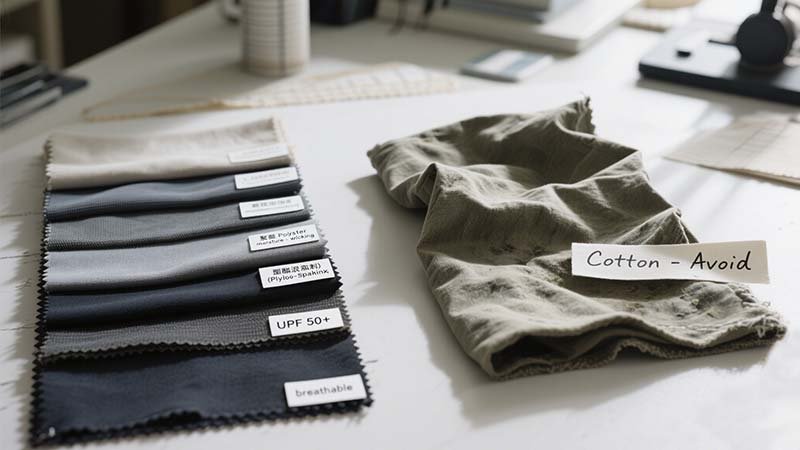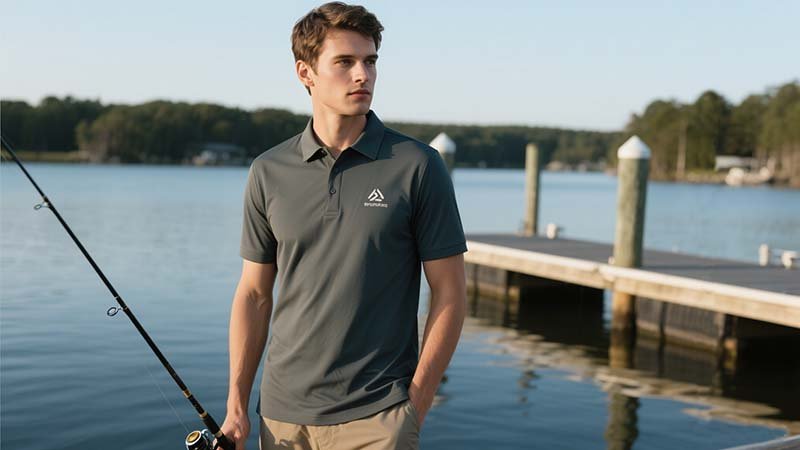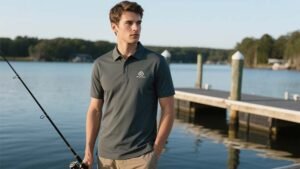Starting your own fishing apparel brand? Choosing the right polo shirt style is one of the most important steps. It’s not just about looks—it’s about function, comfort, and sending the right message.
How do I choose the best fishing polo shirt style for my brand?
Start by understanding who your customer is and what kind of fishing lifestyle they lead. Then, focus on fabric quality, fit, collar design, and custom decoration methods. Each detail—from UPF protection to fabric tech—helps define your brand’s identity. It’s not one-size-fits-all, and your choices can make or break your line.
Let’s break it down step by step and find the style that actually fits your vision.
Who Are You Designing For? Hardcore Anglers vs. Lifestyle Fans
Before I ever picked a fabric or sketched a design, I had to ask myself—who am I really creating this for?
What type of fishing customer is your brand targeting?
There are generally two main groups: the performance-first hardcore anglers and the more relaxed lifestyle crowd. Hardcore folks want function—moisture-wicking, sun protection, and gear compatibility. Lifestyle fans lean into comfort and aesthetic—something they can wear from the dock to the brewery. Know who you’re serving, and you’ll avoid making shirts that miss the mark.

Hardcore Anglers
They live for the bite. Performance is everything. They’re out on the water in the heat, salt, and spray, and they need gear that performs. That means:
- Quick-dry fabrics
- UPF 50+ protection
- Anti-odor tech
- Ventilated panels
- Loops or tabs for tools
A classic polo won’t cut it unless it’s been supercharged with tech.
Lifestyle Fans
They might fish once a month or even just love the look. For them, the shirt needs to feel great and look even better. Features they love:
- Soft-touch fabrics
- Trendy collar shapes
- Bold sublimation prints
- Slim or relaxed fits
- Brand-forward details (like woven patches or embroidered logos)
Knowing your customer helps you pick not just what the shirt does—but what it says.
The Best Fabrics for Fishing Polos (And the Ones to Avoid)
If there’s one lesson I learned early, it’s this: never choose fabric based on how it looks on a screen.
What are the best fabrics for fishing polo shirts?
The top choices are polyester and poly blends with moisture-wicking, UV protection, and breathability. Avoid cotton—it gets heavy, holds sweat, and can make you feel miserable on a hot day. Nylon is okay but can be pricey and less breathable.

Fabric Types Comparison
| Fabric Type | Pros | Cons |
|---|---|---|
| Polyester | Lightweight, quick-dry, durable | Can feel synthetic if low-quality |
| Poly-Spandex | Stretchy, comfy, performance-friendly | Slightly higher cost |
| Nylon | Silky, durable, abrasion-resistant | Warmer, less breathable |
| Cotton (avoid) | Soft, natural feel | Holds moisture, shrinks |
Always test swatches before you commit. I once ordered a batch that looked great in photos—until I realized they felt like plastic raincoats.
Fishing Polo Collars Explained: Which One Matches Your Brand Look?
Collars matter more than most people think. They set the tone. Rugged? Refined? Retro?
Which fishing polo collar style should you choose?
For a classic look, stick with structured knit collars. For a modern edge, go for self-fabric or no-collar athletic styles. If you're appealing to high-end or casual lifestyle markets, a tipped or contrast collar might help your brand stand out.
Collar Style Breakdown
| Collar Type | Look | Best For |
|---|---|---|
| Knit Rib Collar | Traditional polo look | Classic or heritage brands |
| Self-Fabric Collar | Sleek and modern | Performance and minimalist styles |
| Mandarin Collar | Athletic and edgy | Sportier or Asian-inspired brands |
| Contrast Collar | Stylish and trendy | Lifestyle-focused collections |
Each collar tells a story. Make sure it matches your brand’s voice.
Sublimation, Embroidery or Heat Transfer? How to Customize Like a Pro
This is where your creativity can really shine—or where your shirts start peeling in the wash.
What’s the best method to decorate fishing polos?
Sublimation is best for all-over prints and logos on light polyester fabrics. Embroidery offers a premium, textured feel for logos, but can get heavy. Heat transfer is great for sharp logos and low-volume runs but has durability concerns on poor-quality base fabrics.

Custom Method Comparison
| Method | Pros | Cons |
|---|---|---|
| Sublimation | Unlimited color, won’t fade/crack | Only on light polyester fabrics |
| Embroidery | High-end, textured look | Heavy, can warp light fabrics |
| Heat Transfer | Sharp detail, great for logos | May peel or crack over time |
Think about your logo size, shirt fabric, and budget. I’ve made the mistake of putting embroidery on thin polos—it looked great until it puckered after one wash.
Sizing and Fit Secrets: US vs EU Cuts for Fishing Apparel Success
Fit is where a good shirt becomes someone’s favorite shirt.
How do fishing polo fits differ across markets?
US sizing tends to be looser and longer. EU cuts are slimmer and more tailored. Know your target region—and whether your customers want performance movement or a fitted, lifestyle vibe.
Sizing Fit Chart
| Region | Fit Style | Notes |
|---|---|---|
| US | Roomy, longer torso | Great for movement and layering |
| EU | Slim, tailored | More fashionable, closer to the body |
If you’re selling worldwide, consider offering two cuts—or a middle-ground “universal” fit. Nothing kills brand loyalty like inconsistent sizing.
UPF Ratings Explained: Why UV Protection Is a Must for Fishing Shirts
I used to think “sun protection” just meant slapping on sunscreen. I was wrong.
What is UPF and why does it matter for fishing polos?
UPF stands for Ultraviolet Protection Factor. A UPF 50+ shirt blocks about 98% of harmful UV rays. For anglers, that’s not optional—it’s survival. UPF-treated fabrics prevent skin damage, premature aging, and long-term health risks.
UPF Rating Table
| UPF Rating | UV Blocked | Use Case |
|---|---|---|
| 15–24 | 85–94% | Casual wear, cloudy days |
| 25–39 | 94–97% | Light fishing |
| 40–50+ | 97–98+% | Prolonged sun exposure |
Always ask your supplier for UPF certificates. Don’t guess—it’s your customer’s skin on the line.
Stay Cool and Fresh: Must-Have Fabric Technologies for Modern Fishing Polos
There’s more going on in modern polos than meets the eye.
What fabric technologies should you look for in fishing shirts?
Look for moisture-wicking, anti-odor, and cooling finishes. These upgrades make your shirts wearable in the heat, salt, and sweat of real-world fishing. Bonus: they boost your brand’s value without a huge cost jump.
Fabric Tech Checklist
- ✅ Moisture-wicking: Pulls sweat off skin
- ✅ Anti-odor: Silver or bamboo treatments
- ✅ Cooling fibers: Feels cool on contact
- ✅ Ventilation zones: Mesh or laser-cut areas
I still remember one customer review that said, “Your shirt saved my back on a 10-hour charter trip.” That’s the kind of impact tech can have.
Conclusion
Choosing the perfect fishing polo is about more than fabric and stitching—it’s about knowing your customer and bringing your brand’s story to life, one shirt at a time.
.png)

